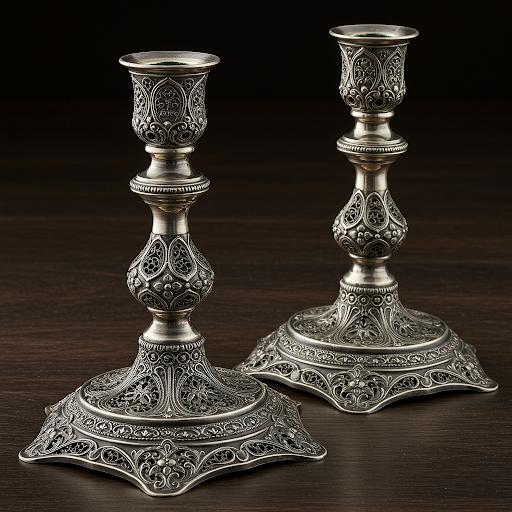
Sephardic Judaica Evolution
Compartir
Tracing the evolution of Sephardic Judaica design reveals a fascinating interplay of cultural
influences and historical events. Here's an overview of the key changes over time:
Early Period (Pre-Expulsion):
* Influence of Islamic Art:
* In Spain, under Islamic rule and later in the Christian kingdoms, Sephardic art was deeply
influenced by Islamic artistic traditions, particularly the Mudéjar style.
* This resulted in the incorporation of intricate geometric patterns, arabesque designs, and
flowing floral motifs in Judaica.
* Manuscript illuminations and synagogue decorations reflected these influences.
* High Level of Craftsmanship:
* Sephardic artisans were renowned for their skill in various crafts, including metalwork,
textiles, and manuscript illumination.
Sephardic filigree, influenced by Islamic and European traditions, often features more geometric
motifs and a greater emphasis on symmetry.
Post-Expulsion Period (1492 Onward):
* Dispersal and Adaptation:
* The expulsion from Spain in 1492 led to the dispersal of Sephardic communities across the
Mediterranean, North Africa, and the Ottoman Empire.
* In their new homes, Sephardic artisans adapted their styles to incorporate local influences.
* Ottoman Influence:
* In the Ottoman Empire, Sephardic Judaica absorbed elements of Ottoman art, including
intricate metalwork and decorative patterns.
* Synagogue architecture also reflected Ottoman styles.
* North African Influences:
* In North Africa, Sephardic communities blended their traditions with local Berber and Arab
artistic styles.
* This resulted in unique forms of Judaica, particularly in metalwork and textiles.
* Western European Influences:
* in western Europe, in places like Amsterdam, Sephardic communities designing Judaica,
began to incorporate design elements that were popular at the time, such as Baroque and
Rococo styles.
* Continuity of Tradition:
* Despite these adaptations, Sephardic Judaica retained core elements of its original
aesthetic, including a focus on intricate detail and a refined sense of design.
Modern Era:
* Preservation and Revival:
* In the modern era, there has been a renewed interest in preserving and reviving Sephardic
artistic traditions.
* Museums and cultural institutions have played a vital role in documenting and exhibiting
Sephardic Judaica.
* Contemporary Sephardic artist, are creating new works, that are inspired by the rich history
of Sephardic design.
Key Themes:
* The adaptability of Sephardic design to different cultural contexts.
* The continuity of core aesthetic values across time and space.
* The importance of cultural exchange in shaping Sephardic artistic traditions.
In essence, Sephardic Judaica design is a testament to the resilience and creativity of a
community that has navigated diverse cultural landscapes while maintaining its unique identity
